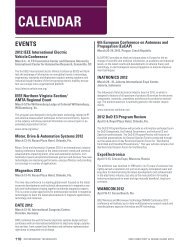Low Frequency Magnetic Shielding - Interference Technology
Low Frequency Magnetic Shielding - Interference Technology
Low Frequency Magnetic Shielding - Interference Technology
You also want an ePaper? Increase the reach of your titles
YUMPU automatically turns print PDFs into web optimized ePapers that Google loves.
© Integran Technologies Inc. 5approximately 400°F (varies, depending on alloycomposition) to avoid grain growth back to alarger crystalline equilibrium state. As with anysolution this approach has its own drawbacks.The metal coating operation is a secondaryoperation which adds cost to the part. Inaddition, the thickness and distribution of metalin a typical deposition process fornanocrystalline metals is influenced by partgeometry. Despite these factors, theapplication process is industrially scalable, andthe metal coating approach is effective wherediscrete shields are awkward or impractical.The part also benefitted from increased surfacehardness, and an aesthetically pleasing finish.Polymer parts can also benefit greatly fromdirect coating with Nanovate EM. Complexmoldings can be coated to provide additionalstiffness, strength and surface hardness inaddition to magnetic shielding, thereby tocreating multifunctional parts. Thesemetal/polymer hybrid parts can be lighter andthinner than their fully metal die‐castcounterparts. Error! Reference source notfound.Figure 7 depicts a cell phone housingcoated with Nanovate EM, adding stiffnessand strength to the polymer part. Figure 8shows a similar polymer housing with thecoating applied selectively. This deliversshielding performance where it’s required,eliminating unnecessary weight. Using aselective coating process can enable monolithicintegration of discrete parts in an assembly,reducing part cost.Figure 7 ‐ Polymeric cell phone components coated withnanocrystalline Nanovate shielding. Source: IntegranTechnologies Inc.An example of a metal part which can benefitfrom direct part coating is shown in Figure 6which depicts a complex aluminum machinedhousing that required shielding. The applicationis weight sensitive and required layups of mumetalfoils in most areas and labor intensivework to bend the foils and bond them to shieldthe corners. As an alternative, 50 microns thickNanovate EM coating was applied by IntegranTechnologies. The part has performed well ininitial EMI testing and the majority of the foilscould be eliminated, saving weight and cost.Figure 8 ‐ Polymeric cell phone component selectively coatedwith nanocrystalline Nanovate shielding. Source: IntegranTechnologies Inc.3.3 Material Property Benefits of NanovateEMAnother useful property of nanocrystallineNanovate EM coatings is that they have ahigher strength and hardness than their coarsegrainedcounterpart materials. When appliedto polymer substrates, this higher strength canbe used to dramatically increase the strengthand stiffness of the hybrid part. A relatively





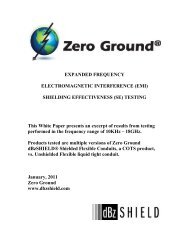
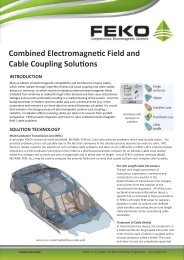

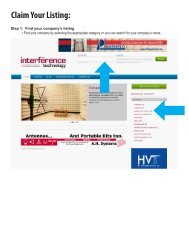
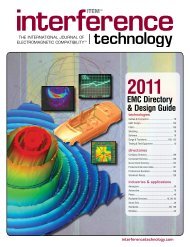

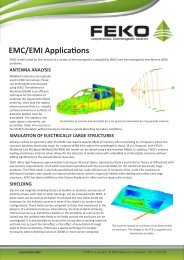
![[ thursday ] morning sessions 8:30 am-noon - Interference Technology](https://img.yumpu.com/23176841/1/190x247/-thursday-morning-sessions-830-am-noon-interference-technology.jpg?quality=85)
